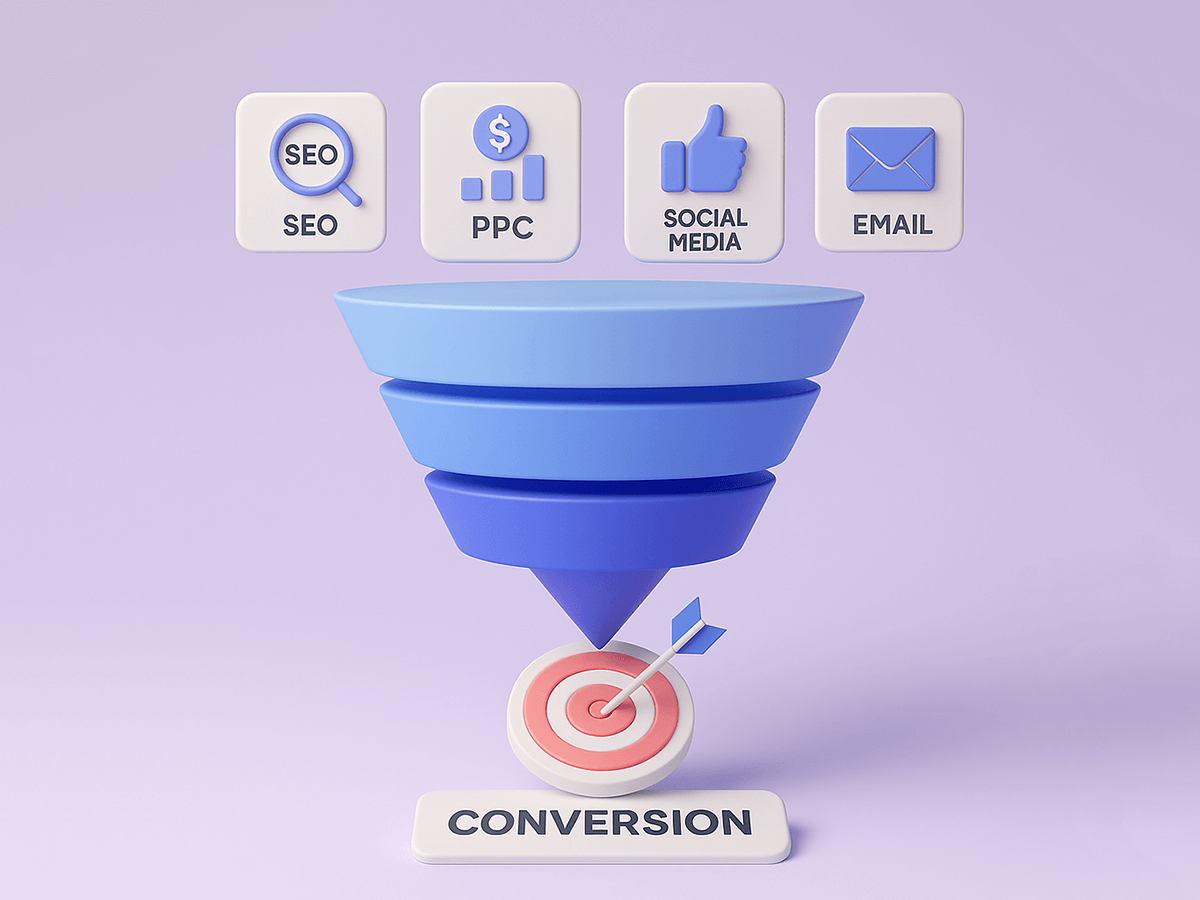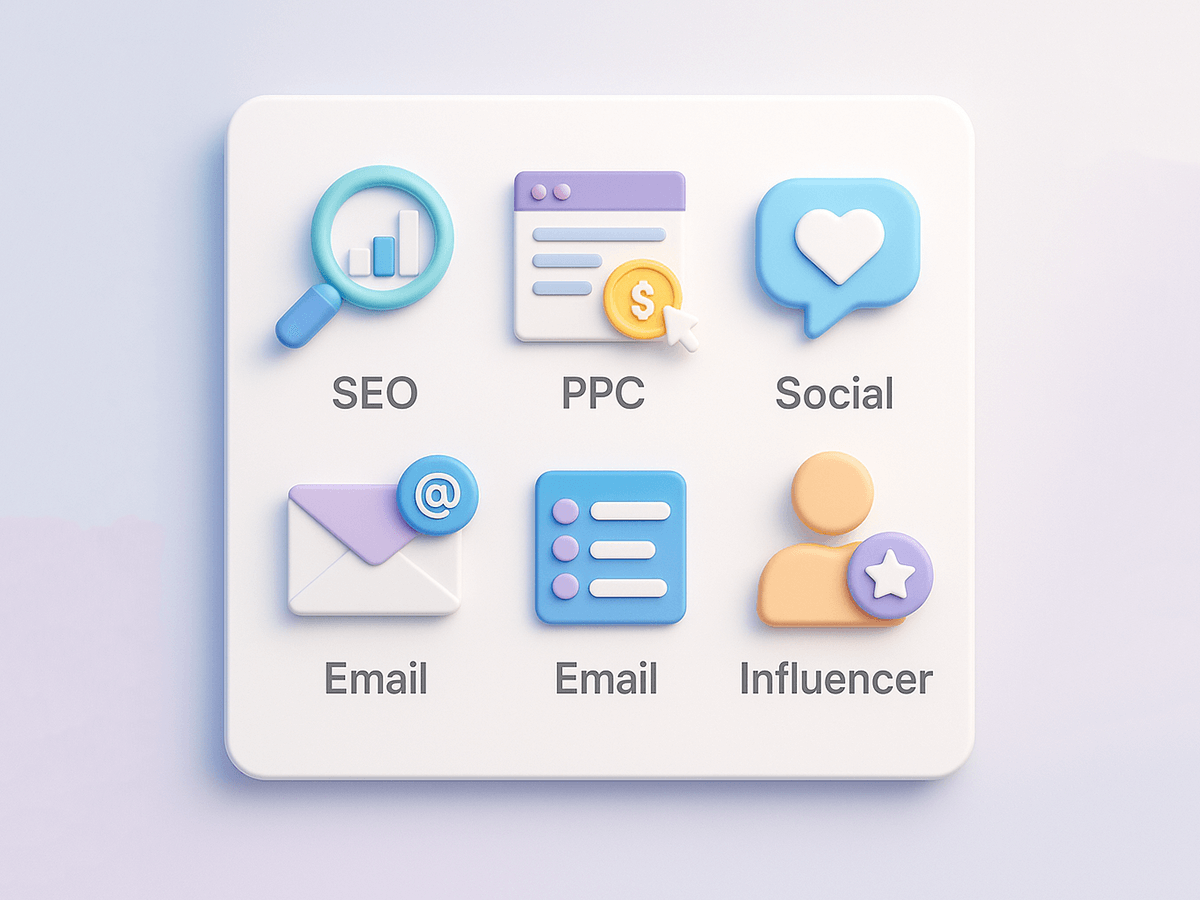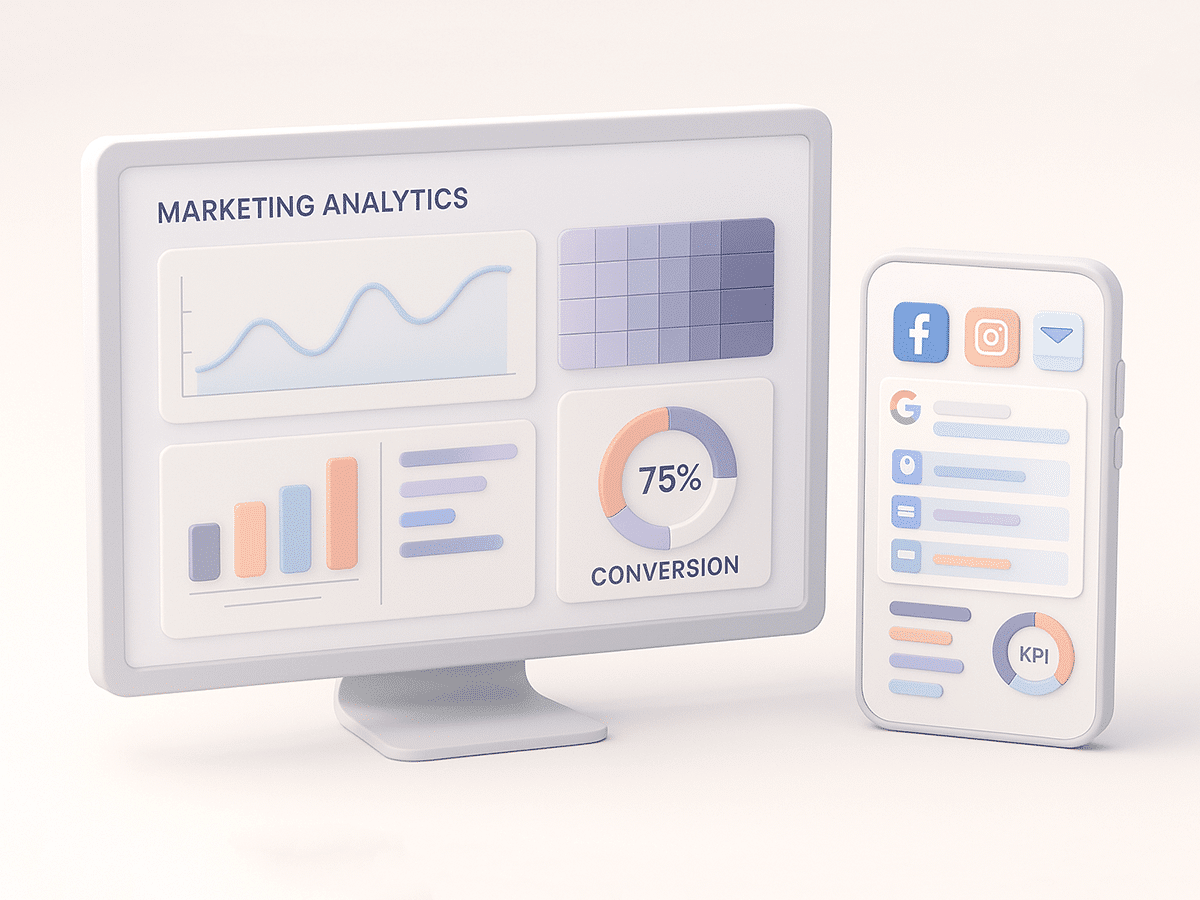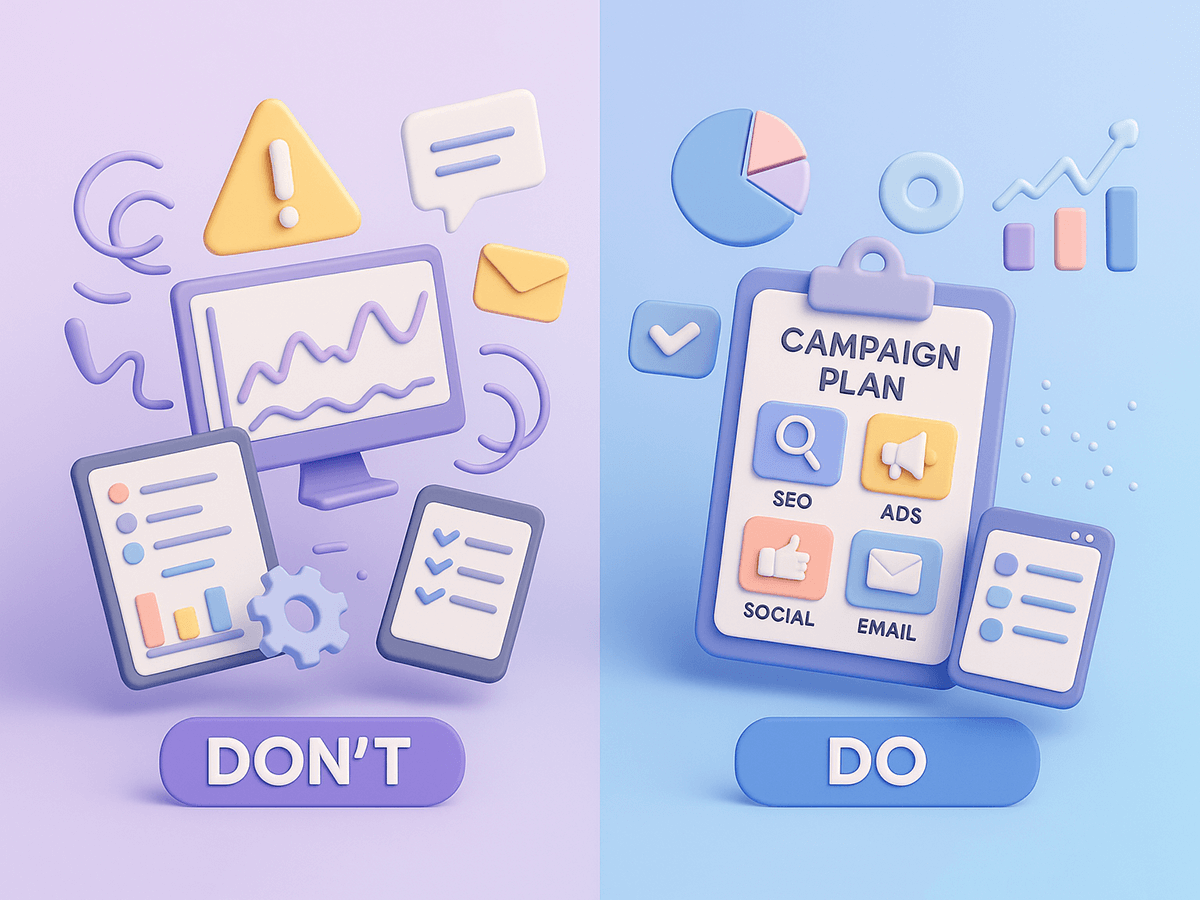
Digital Marketing Campaigns: Strategies, Examples & Best Practices
Too often, businesses dive into digital marketing without a clear plan—just content here, a few ads there, and hope for the best. But a well-structured digital marketing campaign plays a key role in business growth. It helps you reach the right audience, stay consistent across channels, and turn effort into measurable results.
This guide walks you through what a digital marketing campaign really involves, why structure matters, and how to build one with confidence. We’ll cover essential strategies and highlight best practices to help you create campaigns that actually work. Let's dive in!

What Is a Digital Marketing Campaign?
A digital marketing campaign is a focused, goal-driven series of marketing efforts carried out across digital channels to reach your audience and guide them toward a specific action, such as signing up for a newsletter, purchasing a product, or booking a service. Unlike general digital marketing, which may be ongoing and broad, campaigns are time-bound and built around clear objectives that connect your brand with the right consumers.
Think of it as a strategic playbook. Instead of scattering posts or ads across the internet, you're creating a coordinated flow where your message, media, and channels work together to guide people from awareness to consideration to conversion. It turns content creation into a results-focused system.
A high-performing digital marketing campaign often blends several key components:
- SEO and content marketing to increase visibility and build trust with search-driven traffic.
- PPC advertising for fast, targeted reach and measurable ROI.
- Social media to engage, educate, and entertain your audience in real time.
- Email marketing to nurture leads with tailored content and strong calls to action.
Each of these tools has its own role, but when they work together, they create a smooth and consistent experience that gently guides consumers toward the next step.
And the secret behind every effective campaign? A solid strategy. That means defining your goals early, understanding your audience deeply, and using data to continually refine your approach. Even small tweaks, like adjusting an ad creative or testing a subject line, can lead to meaningful improvements when your plan is guided by real insight instead of guesswork.

Key Digital Marketing Strategies for a Successful Campaign
No two campaigns look exactly the same, but the most effective ones have one thing in common: they’re built on the right mix of strategies, aligned with specific goals and the behaviors of your audience.
Choosing the right digital marketing tactics across various digital channels can elevate your brand and deliver measurable results. Below are five core approaches that power high-performing campaigns across the digital world.
1. SEO & Content Marketing
Search engine optimization (SEO) and content marketing are foundational in the digital space. Together, they ensure your content not only ranks well but also provides value that builds long-term credibility.
Begin by diving into your audience’s search intent. What questions are they asking online? Build content creation efforts around those queries by using blog posts, how-to articles, and even video content to provide relevant solutions. Technical SEO is also critical: optimize your site structure, page speed, and mobile experience.
Many brands use a content cluster model, building topic-based libraries that support authority and visibility. This approach brings in organic traffic while also helping your customers learn and feel more confident at every step.
2. Pay-Per-Click Advertising (PPC)
When you need quick visibility and control, PPC is your go-to. It’s a form of advertising that lets you appear directly in front of people who are actively searching or scrolling, whether on Google, YouTube, or social media platforms.
What sets the best PPC campaigns apart isn’t a bigger budget, but a smarter approach to how that budget is used. Define clear goals, choose the target audience, and design ads that grab attention fast. Use clear messaging and match your ad to a dedicated landing page for higher conversions.
A/B testing, budget adjustments, and performance tracking allow you to stay agile. When PPC is paired with strong organic content, it creates a well-rounded digital marketing funnel that captures and converts users at different touchpoints.
3. Social Media Marketing
Social media opens the door to meaningful connections. It gives your brand a space to share stories, start conversations, and build relationships in real time.
Different platforms serve different purposes. Instagram and TikTok lean heavily into video and visual storytelling, while LinkedIn is ideal for thought leadership and B2B engagement. Even X (formerly Twitter) still plays a role in real-time dialogue and industry news.
Strong campaigns blend formats: carousels, reels, live sessions, polls, behind-the-scenes content, and user-generated content (UGC). Showing up on social media is only part of the equation. What really makes a difference is being intentional, engaging with your community, responding to comments, and creating space for real conversations that build trust.
Don’t just track likes. Focus on engagement rates, reach, and meaningful interactions to understand what’s clicking and where to double down.
4. Email Marketing & Automation
Email remains one of the most powerful tools for moving people from awareness to action. It lands directly in your audience’s inbox, making it highly personal and effective when done right.
Great email campaigns do more than promote your products. A friendly welcome, useful tips, and occasional updates help build stronger connections with your customers. When your emails match what someone needs—whether they’re just getting to know you or already buying regularly—they feel more relevant and more likely to be opened.
Tools like Klaviyo or Mailchimp make this easy to manage. You can set up follow-ups, cart reminders, and thank-you messages that run automatically, so your emails stay consistent without adding extra work to your plate.
5. Influencer & Affiliate Marketing
In a noisy digital space, authentic voices cut through. Influencer marketing taps into that by leveraging creators your audience already trusts.
You don’t need celebrity-level influencers to make an impact. Micro and niche creators often drive more engagement because their communities are more connected. Work together on product reviews, short videos, tutorials, or brand storytelling in a way that feels genuine and not overly scripted.
Affiliate marketing adds a performance-based layer, giving partners a financial incentive to share your products or services. This is especially valuable for e-commerce brands looking to extend reach with minimal upfront risk.
When these strategies come together smoothly, they can boost your reach, increase conversions, and create buzz through the power of social proof.

How to Plan and Execute a High-Performing Digital Marketing Campaign
You’ve got the strategy—now it’s time to bring it to life. Planning a digital marketing campaign should feel like building something that matters. Every choice you make, from the message to the channels you use, plays a role in how your audience experiences your brand.
Let’s say you’re gearing up to launch a new line of sustainable skincare products. You’ve done the product development, sourced eco-friendly packaging, and now it’s time to go to market. A digital marketing campaign will be your main driver.
But how do you build a campaign that’s more than just hype? One that aligns with your goals, speaks to the right audience, and delivers measurable results? Let’s walk through it.

Step 1: Set Clear Campaign Goals
Your goals are the foundation of your campaign. They determine your message, targeting, channel mix, and success metrics. Without them, you’re just creating content in the dark.
There are different types of campaign goals, and each one requires a different approach:
- Awareness: Increase visibility, reach new audiences, grow followers
- Engagement: Drive clicks, comments, shares, and conversations
- Lead Generation: Capture emails, sign-ups, or downloads
- Sales/Conversions: Direct purchases, trials, bookings
- Retention: Re-engage past customers, build loyalty
A well-defined goal for your skincare launch might be:
"Generate 1,000 purchases and grow our email list by 3,000 leads within 30 days of launch.”
Notice it’s specific, measurable, and time-bound, which makes it easier to track and optimize.
Pro tip: Tie your goals to funnel stages (awareness → interest → decision → action). That way, you can create content and messaging that guides people through a journey, not just a moment.

Step 2: Identify Your Target Audience & Build Buyer Personas
You’re not marketing to “everyone who likes skincare.” You're marketing to a specific type of person who will actually resonate with your brand values and offering.
To define your audience, go beyond demographics and dig into behavior, mindset, and intent:
- What problems are they trying to solve?
- Where do they hang out online?
- How do they research before buying?
- What kind of content do they engage with?
Let’s go back to your skincare brand. You discover through surveys and Instagram engagement that your audience values sustainability, but also craves simplicity. Many feel overwhelmed by 10-step routines and are looking for easy, trustworthy solutions.
From here, you develop two personas:
- Sophie, 29, eco-conscious, wellness-focused, follows sustainable lifestyle creators on TikTok.
- Ryan, 35, time-strapped professional, new to skincare, wants a simple solution that just works.
These insights do more than guide your targeting. They influence your tone, help you choose the right channels, and make it easier to create content that actually connects.

Step 3: Choose the Right Marketing Channels
You don’t need to be everywhere. You need to be where your audience is and deliver the right message, in the right format, at the right time.
The key is channel alignment. Each platform has strengths, limitations, and expectations:
- SEO & content marketing build long-term trust and visibility
- Google Ads capture high-intent traffic ready to act now
- Social media drives conversation, brand presence, and community
- Email marketing nurtures relationships and boosts retention
- Influencer marketing builds trust and expands reach through shared audiences
In the skincare campaign, you focus on:
- TikTok and Instagram Reels for storytelling and visual product education
- Email sequences to guide leads through launch with early access offers
- Google Search and Shopping ads for users actively searching clean skincare products
This cross-channel setup ensures your brand shows up at multiple touchpoints, without spreading your budget or team too thin.

Step 4: Develop & Optimize Campaign Content
Once your strategy is set, the creative comes into play. This is where your brand voice, visual identity, and value proposition come to life.
Content should be:
- Relevant to the audience and platform
- Goal-driven (what action do you want the user to take?)
- Consistent in tone, message, and visual feel
- Flexible for testing and adaptation
For your skincare line, you might create:
- Behind-the-scenes IG Reels showing how the product is made
- A landing page that highlights your sustainability promise with a simple, scannable layout
- A quiz that helps first-time users find the right product bundle
- Email content that educates, builds trust, and nudges people toward conversion
Most campaigns don’t nail it all on the first try. That’s why optimization matters. Monitor performance in real time, and be ready to test:
- CTA buttons vs. links
- Short-form vs. long-form emails
- Product-focused ads vs. benefit-driven storytelling
Good content gets attention. Great content converts.

Step 5: Monitor, Measure & Adjust
Campaigns are living things. Launch day is not the finish line—it’s where the learning starts.
Set up dashboards and tracking early using:
- UTMs for traffic sources
- Google Analytics for behavior insights
- Meta Ads Manager for cost-per-action tracking
- Email platforms for engagement metrics
- Heatmaps for visual insights on landing pages
For your skincare campaign, let’s say you notice that while your TikTok ads are generating strong traffic, your landing page bounce rate is high. That’s a sign your messaging or layout may need to be tightened.
You also see that emails with short, casual subject lines are outperforming polished ones, so you adjust the next batch to match that tone.
What matters isn’t launching the “perfect” campaign. It’s launching, learning, and iterating based on data and feedback.

Common Mistakes to Avoid in Digital Marketing Campaigns
Even with the best intentions, digital marketing campaigns can fall short when foundational steps are skipped. These common missteps can drain budgets, confuse potential clients, and hold your sales back from reaching their full potential. The good news? Most of these issues are avoidable with the right planning, tools, and a bit of foresight.
Below are some of the most frequent mistakes marketers and business owners make, and how to stay ahead of them.
1. Failing to Define Clear Goals
Starting a campaign without a specific goal is like launching a product with no market in mind. You might get attention, but it won’t lead to meaningful action or results.
Vague objectives like “increase traffic” or “boost visibility” don’t provide enough direction. Instead, define goals tied to performance, such as:
- Drive 3,000 qualified visitors to your website
- Increase product sales by 20% this quarter
- Convert 15% of webinar sign-ups into paying customers
Specific, measurable outcomes help align your message, media spend, and internal team efforts.
2. Ignoring Audience Segmentation
Not all consumers think, shop, or interact the same way. Treating your entire audience as one group often leads to low engagement and higher bounce rates.
Smart digital marketing relies on segmentation, which means dividing your clients or prospects into groups based on behavior, intent, or demographics. For instance:
- New leads may need educational content.
- Existing customers could respond better to loyalty incentives.
- High-value buyers might expect VIP treatment or early access.
Use tools like CRM data, social media insights, and site behavior to personalize your approach. Done well, this builds stronger connections and drives higher ROI.
3. Focusing Only on One Channel
It might feel safer to stick with one familiar platform, but putting all your eggs in one basket limits reach and increases risk. Algorithms change. Attention shifts. And what worked last month may not work now.
Today’s consumers move across platforms. A user might:
- See your ads on Instagram
- Google your brand name later
- Visit your website for reviews
- And convert after an email reminder
That’s why multi-channel campaigns work better. Align your message across media, from search to email, and you’ll stay connected with your audience wherever they are. You don’t need to be on every channel, but the right mix creates more consistent results.
4. Neglecting Campaign Analytics
This is where even experienced marketers sometimes drop the ball. Running a campaign without measuring performance is like speaking without listening, and it breaks the connection between your message and what people actually want.
Set up tracking before launch using tools like:
- UTM codes and event goals in Google Analytics
- Conversion tracking for ads
- Email performance reports
- Behavior tracking on your site
Then, use these insights to optimize in real time. For example, if email open rates are low, test new subject lines. If a landing page isn’t converting, revisit the headline or CTA placement.
Data isn’t just something you review after the fact. It helps you make smarter decisions, improve your results, and create a better experience for the people you’re trying to reach.

Wrapping Up
You don’t need a big budget or a well-known name to run a campaign that works. What really matters is knowing your goal, understanding your audience, choosing the right place to reach them, and focusing on building genuine connections. Whether it's through SEO, paid ads, email, or social, the goal is the same: create something that feels honest, resonates with your audience, and inspires action.
That’s exactly what we do at KUMO Studio. As a digital marketing agency, we partner with brands to design and run campaigns that are built to perform. We don’t just deliver services, we work alongside our clients to create strategies that are smart, creative, and tailored to what actually drives growth.
If you're ready to build campaigns that make an impact, we’d love to hear from you. Reach out to KUMO Studio and let’s create something meaningful together.
- Categories:
- Digital Marketing (5)
Ready to bring your goals to life?

